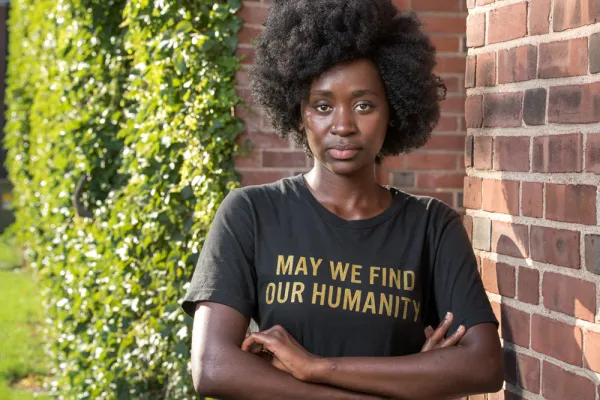Changing the Narrative for Women
Campus Life

Published September 21, 2020
Hawa Tarawally AC was born at the height of the “blood diamond” civil war between her home country of Sierra Leone and Liberia. Daily life in Tonga Field was punctuated by the constant pop-pop-pop of gunshots and threats of rebel attacks. Her mother died in the war. She was 9 before she started school; that’s where she finally felt safe, she said.
But as a teenager, she was pushed by her family to get married; when she refused, she was forced to leave her uncle’s house and was homeless for nearly a year. That was the beginning of her journey to continue her education, a journey that included a move to Freetown, Sierra Leone, where she began to advocate for women’s rights; an unplanned departure to the United States; and a circuitous arrival in western Massachusetts. At 21, she entered Greenfield Community College and later transferred as an Ada Comstock Scholar to Smith, where she is a junior majoring in government and economics.
Last spring, as racial injustices fueled protests around the country, Tarawally began speaking out with other activists in Northampton and Amherst. “I want to speak up for anything that is unjust,” she said, “and fight for the people who feel as if they don’t have the power to fight for themselves.”
I REMEMBER MY first day in school in my village. I loved it—seeing the woman in front of me in that dusty classroom, teaching us our ABCs, was powerful. But when you get to fifth or sixth grade, girls leave school and soon get married. None of my aunties have ever been to school. All the women that I grew up seeing in my village, none of them have been to school. Some have five babies with one kid hanging onto them. I knew that wasn’t me. I didn’t want that for myself even at that age.
THE IDEA THAT I have to be like every other woman, that I had to live with the disparities that women and young girls face in Sierra Leone, that I had to simply accept harmful traditional practices, that I had to witness injustice and remain quiet about it is what drove me to the U.S. The one thing I know is that until women take responsibility to empower other women—as sisters, as part of themselves— until we are able to do that for ourselves, no man in his right senses will ever take power and give it to us. Especially those in the highest offices around the world. Thanks to the encouragement and support of some amazing alumnae, I found Smith.
“The idea that I had to be like every other woman ... to witness injustice and remain quiet about it is what drove me to the U.S.”
I HEARD THAT Smith was very involved in activism and changing the status quo for women. I thought, “That is exactly what I’m looking for.” Smith is home to a community of like-minded women—women who understand that it’s our time to shape our own narratives. Getting into Smith has been the single most powerful gift the universe has given me.
THE THINGS I’M learning at Smith, the friendships I’ve built and the connections, I’m telling you a fire has been sparked! Having the privilege to be taught by the professors here—oh, my goodness! They love what they do so much you have no choice but to fall in love with the subject. Like [Professor of the Study of Women and Gender] Carrie Baker, for instance. Each time I went to her class on the impact of gender on law and public policy, I left feeling like a fire in me had been sparked.
MY GOVERNMENT PROFESSOR, Alice Hearst, suggested that I go to law school; this was the universe telling me what I already knew. So I plan to go on to law school, and I am going to be a well-trained and highly qualified lawyer. I want to use the opportunity that Smith has given me to continue my education, to gather everything I’ve learned and take it to the next level—affecting people’s lives for the good, starting with my country, Sierra Leone. That is why I am here.
This story appears in the Fall 2020 issue of the Smith Alumnae Quarterly.
Photograph by Shana Sureck